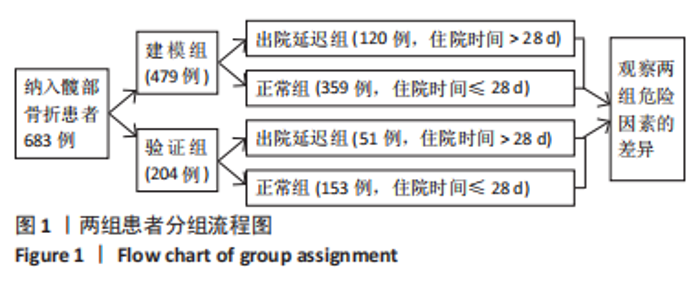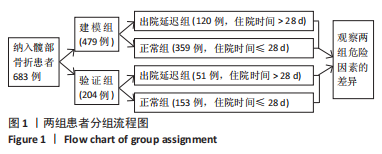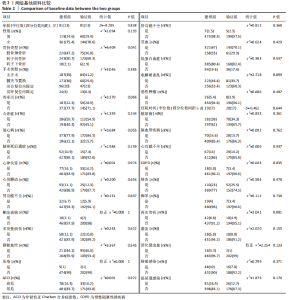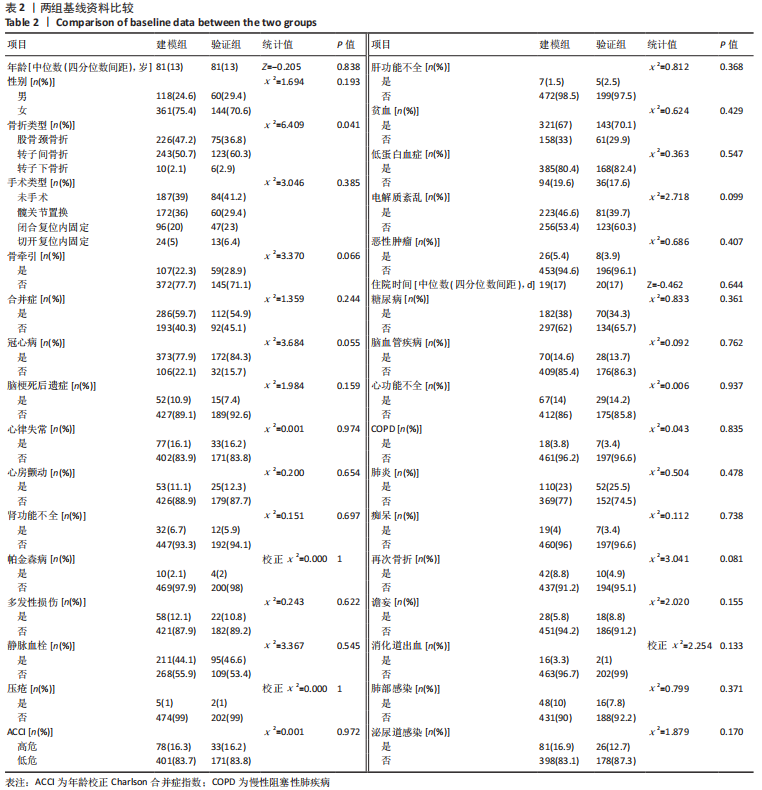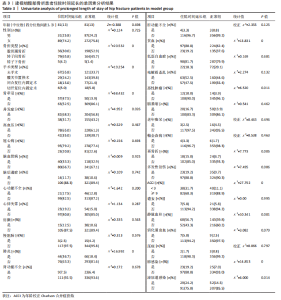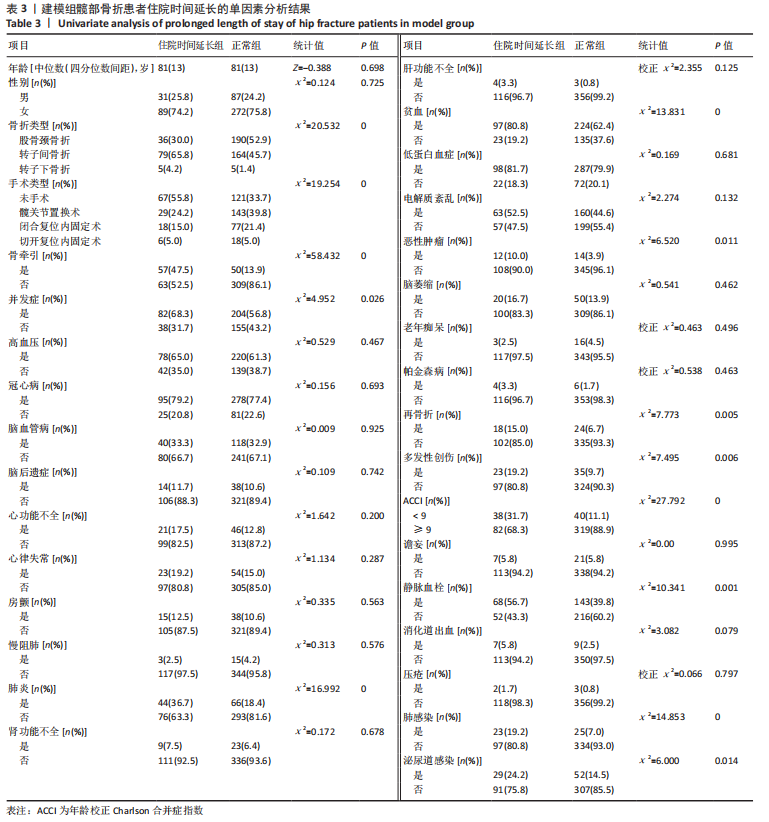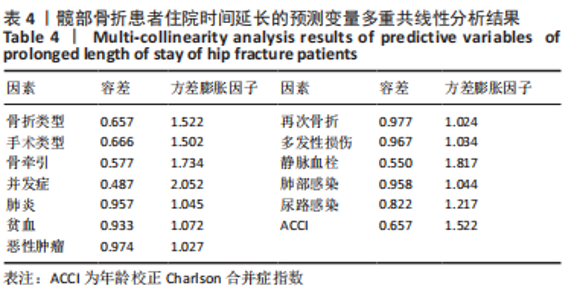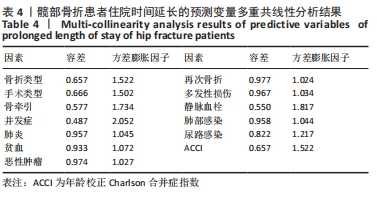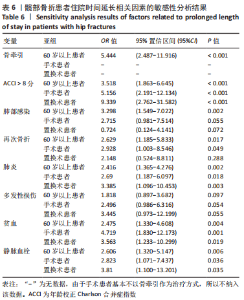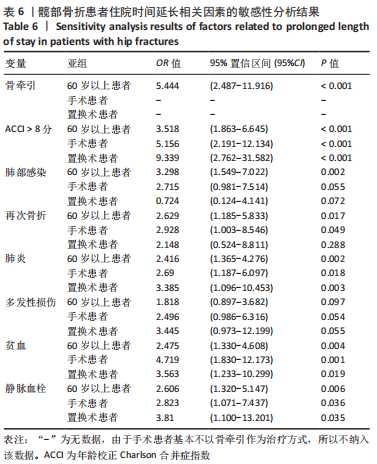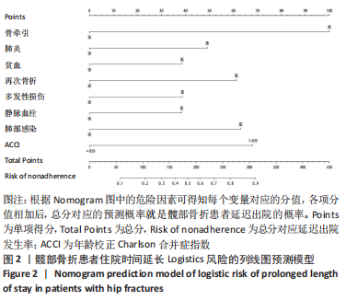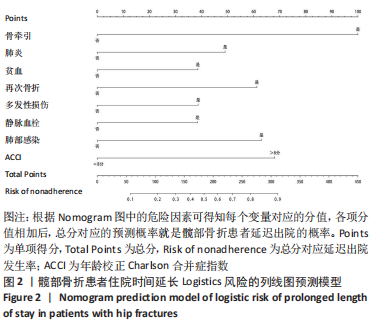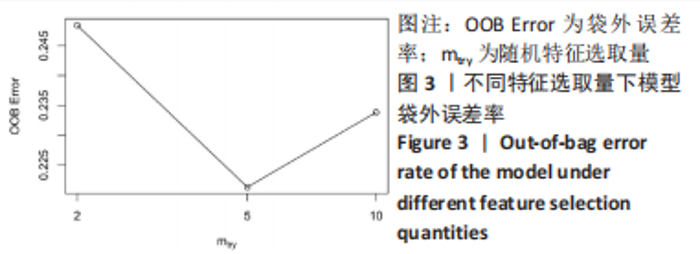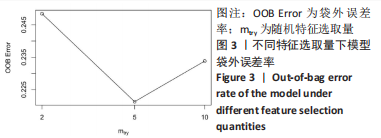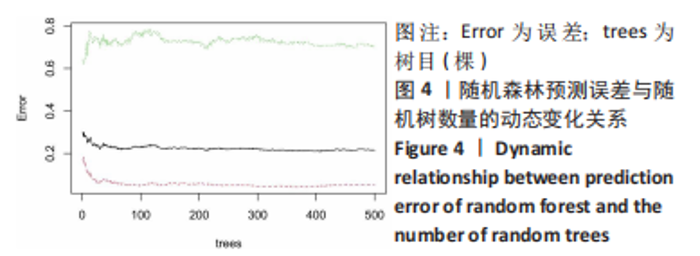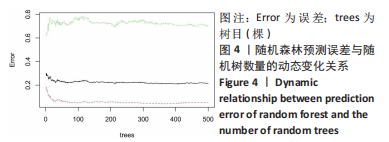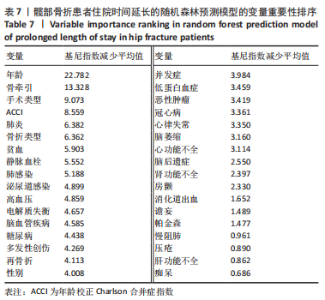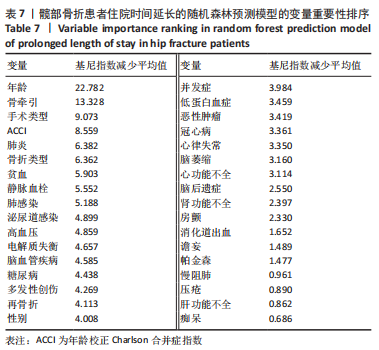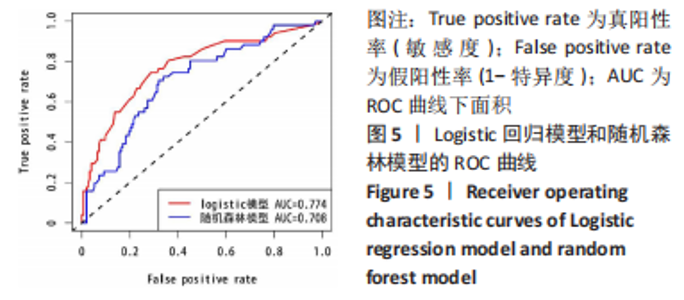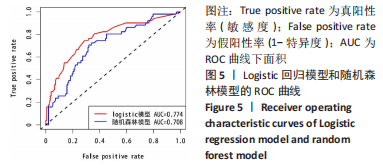Chinese Journal of Tissue Engineering Research ›› 2023, Vol. 27 ›› Issue (34): 5413-5420.doi: 10.12307/2023.744
Comparison of random forest model and logistic regression model in predicting the prolonged length of stay of hip fracture patients
Yu Jian1, 2, Zhou Bingqian2, Wang Zhao2, Li Yue2, Chang Yaru2, Cao Hong1, 2
- 1Department of Trauma Orthopedics, Tianjin Hospital, Tianjin 300202, China; 2Graduate School of Tianjin University of Traditional Chinese Medicine, Tianjin 300061, China
-
Received:2022-10-19Accepted:2022-12-09Online:2023-12-08Published:2023-04-20 -
Contact:Cao Hong, Master, Associate chief senior nurse, Department of Trauma Orthopedics, Tianjin Hospital, Tianjin 300202, China; Graduate School of Tianjin University of Traditional Chinese Medicine, Tianjin 300061, China -
About author:Yu Jian, Master candidate, Senior nurse, Department of Trauma Orthopedics, Tianjin Hospital, Tianjin 300202, China; Graduate School of Tianjin University of Traditional Chinese Medicine, Tianjin 300061, China
CLC Number:
Cite this article
Yu Jian, Zhou Bingqian, Wang Zhao, Li Yue, Chang Yaru, Cao Hong. Comparison of random forest model and logistic regression model in predicting the prolonged length of stay of hip fracture patients[J]. Chinese Journal of Tissue Engineering Research, 2023, 27(34): 5413-5420.
share this article
Add to citation manager EndNote|Reference Manager|ProCite|BibTeX|RefWorks
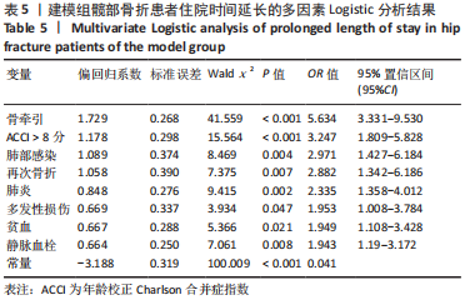
2.5 建模组患者住院时间延长的多因素分析结果 将单因素分析有意义及不存在多重共线性的危险因素进行多因素Logistic回归分析,采用向前逐步法及似然比检验剔除了无统计学意义的混杂因素,获得纳入模型变量。自变量赋值方法如下:骨折类型:股骨颈骨折=0,转子间骨折=1,转子下骨折=2;手术类型:未手术=0,髋关节置换术=1,闭合内固定术=2,切开内固定术=3;ACCI:低危=0,高危=1;骨牵引、并发症、肺炎、贫血、再次骨折、多发性创伤、静脉血栓、肺感染、泌尿道感染、恶性肿瘤:是=1,否=0。结果显示,骨牵引、ACCI、肺部感染、再次骨折、肺炎、多发性创伤、贫血、静脉血栓是髋部骨折患者住院时间延长的独立影响因素,见表5。"
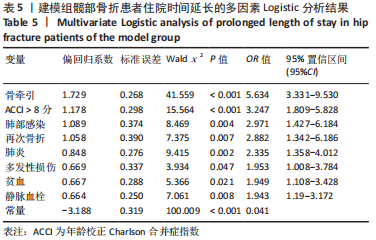
| [1] VERONESE N, MAGGI S. Epidemiology and social costs of hip fracture. Injury. 2018;49(8):1458-1460. [2] BHANDARI M, SWIONTKOWSKI M. Management of acute hip fracture. N Engl J Med. 2017;377(21):2053-2062. [3] LIM J. Big data-driven determinants of length of stay for patients with hip fracture. Int J Environ Res Public Health. 2020;17(14):4949. [4] YOO J, LEE JS, KIM S, et al. Length of hospital stay after hip fracture surgery and 1-year mortality. Osteoporos Int. 2019;30(1):145-153. [5] 刘强,胡永成.骨质疏松性骨折诊疗指南[J].中华骨科杂志,2017,37(1):1-10. [6] 施毅.中国成人医院获得性肺炎与呼吸机相关性肺炎诊断和治疗指南(2018年版)[J].中华结核和呼吸杂志,2018,41(4):255-280. [7] BATTLE DE. Diagnostic and statistical manual of mental disorders (DSM). Codas. 2013;25(2):191-192. [8] 李晓强,张福先,王深明.深静脉血栓形成的诊断和治疗指南(第三版)[J].中国血管外科杂志(电子版),2017,9(4):250-257. [9] CHOE HS, LEE SJ, YANG SS, et al. Summary of the UAA-AAUS guidelines for urinary tract infections. Int J Urol. 2018;25(3):175-185. [10] RAO SJ. Regression modeling strategies: with applications to linear models, Logistic regression, and survival analysis. J Am Stat Assoc. 2003;98:461,257-258. [11] 胡登炯.全髋关节置换治疗老年髋部骨折术后住院时间延长的相关因素分析[D].南昌:南昌大学,2021. [12] 刘思源,唐晓宁,陈攀宇,等.全髋关节置换患者延迟出院相关危险因素分析[J].中华关节外科杂志(电子版),2021,15(5):521-527. [13] 杨锐敏.影响老年髋部骨折住院时长的相关因素分析[D].广州:广州中医药大学,2021. [14] WONG BLL, CHAN YH, O’NEILL GK, et al. Frailty, length of stay and cost in hip fracture patients. Osteoporos Int. 2022. doi: 10.1007/s00198-022-06553-1. [15] EK S, MEYER AC, HEDSTROM M, et al. Hospital length of stay after hip fracture and it’s association with 4-month mortality-exploring the role of patient characteristics. J Gerontol A Biol Sci Med Sci. 2022;77(7):1472-1477. [16] SHEIKH HQ, ALNAHHAL A, Aqil A, et al. Length of hospital stay following hip fracture and risk of 30 and 90 day mortality in a United Kingdom cohort. Acta Orthop Belg. 2021;87(4):607-617. [17] NTULI M, FILMALTER CJ, WHITE Z, et al Length of stay and contributing factors in elderly patients who have undergone hip fracture surgery in a tertiary hospital in South Africa. Int J Orthop Trauma Nurs. 2020;37:100748. [18] CASTELLI A, DAIDONE S, JACOBS R, et al. The determinants of costs and length of stay for hip fracture patients. PLoS One. 2015;10(7):e0133545. [19] GREENSTEIN AS, GORCZYCA JT. Orthopedic surgery and the geriatric Patient. Clin Geriatr Med. 2019;35(1):65-92. [20] WONG RMY, ZU Y, CHAU WW, et al. High Charlson Comorbidity Index Score is associated with early fracture-related complication for internal fixation of neck of femur fractures. Sci Rep. 2022;12(1):4749. [21] WEI J, ZENG L, LI S, et al. Relationship between comorbidities and treatment decision-making in elderly hip fracture patients. Aging Clin Exp Res. 2019;31(12): 1735-1741. [22] SHEN J, YU Y, WANG C, et al. Association of preoperative medication with postoperative length of stay in elderly patients undergoing hip fracture surgery. Aging Clin Exp Res. 2021;33(3):641-649. [23] DI MONACO M, CASTIGLIONI C, VALLERO F, et al. Concomitant upper limb fractures and short-term functional recovery in hip fracture patients: does the site of upper limb injury matter? Am J Phys Med Rehabil. 2015;94(5):366-372. [24] JUHASZ K, BONCZ I, KANIZSAI P, et al. Ellenoldali csípőtáji törésekkel összefüggő halálozás és kockázati tényezőinek vizsgálata [Analysis of mortality and its predictors in patients with contralateral hip fracture after femoral neck fracture]. Orv Hetil. 2017;158(20):783-790. [25] TREVISAN C, BEDOGNI M, PAVAN S, et al. The impact of second hip fracture on rehospitalization and mortality in older adults. Arch Gerontol Geriatr. 2020;90:104175. [26] 李宇能,刘昊楠,蒋协远,等.人工股骨头与全髋关节置换治疗老年移位型股骨颈骨折的成本效果分析[J].中国医刊,2019,54(10):1094-1098. [27] NEWMAN JM, SZUBKSKI CR, BARSOUM WK, et al. Day of surgery affects length of stay and charges in primary total hip and knee arthroplasty. J Arthroplasty. 2017;32(1):11-15. [28] SANTONI BG, DIAZ MA, STOOPS TK, et al. Biomechanical investigation of an integrated 2-screw cephalomedullary nail versus a sliding hip screw in unstable intertrochanteric fractures. J Orthop Trauma. 2019;33(2):82-87. [29] NISSENHOLTZ A, LEVY Y, COOPER L, et al. Anemia in patients after hip fracture repair surgery. Harefuah. 2020;159(9):689-693. [30] 全静,谌旻欢,董璐,等.髋关节置换者术前血红蛋白水平与住院时间的相关性[J].贵州医科大学学报,2022,47(5):581-587. [31] 张丽,张春雷.围术期异体输血对骨科大手术患者凝血功能和免疫功能的影响[J].中国现代医药杂志,2020,22(12):49-52. [32] GUPTA S, FERNANDES RJ, RAO JS, et al. Perioperative risk factors for pulmonary complications after non-cardiac surgery. J Anaesthesiol Clin Pharmacol. 2020; 36(1):88-93. [33] SALARBAKS AM, LINDEBOOM R, NIJMEIJER W. Pneumonia in hospitalized elderly hip fracture patients: the effects on length of hospital-stay, in-hospital and thirty-day mortality and a search for potential predictors. Injury. 2020;51(8):1846-1850. [34] BLASI F. Lung diseases: chronic respiratory infections. Int J Mol Sci. 2018;19(10):3051. [35] TRIVEDI NN, ABOLA MV, KIM CY, et al. The incremental cost of inpatient venous thromboembolism after hip fracture surgery. J Orthop Trauma. 2020;34(4):169-173. [36] FENG L, XU L, YUAN W, et al. Preoperative anemia and total hospitalization time are the independent factors of preoperative deep venous thromboembolism in Chinese elderly undergoing hip surgery. BMC Anesthesiol. 2020;20(1):72. [37] 李斐雯,李萍,白春花.基于机器学习的肾移植受者术后抑郁的预测模型建立[J].中国临床研究,2022,35(8):1168-1172. |
| [1] | . Changes in Lumbosacral Sagittal Plane Parameters of L5/S1 Disc Herniation [J]. Chinese Journal of Tissue Engineering Research, 2023, 27(在线): 1-6. |
| [2] | Sun Jiajia, Zhu Haidi, Lu Yun, Zhang Kai. Comparison of bone metabolism markers between type 2 diabetes mellitus and non-type 2 diabetes mellitus patients with hip fracture [J]. Chinese Journal of Tissue Engineering Research, 2023, 27(8): 1156-1160. |
| [3] | Shen Lianwei, Zhu Hongliu, Wang Wei. Risk factor analysis of metabolic syndrome and construction of a nomogram prediction model in middle-aged and elderly people [J]. Chinese Journal of Tissue Engineering Research, 2023, 27(5): 657-662. |
| [4] | Liu Guangluan, Guo Zonglei, Ge Jin, Huang Dong, Wang Yehua. Anatomic risk factors for medial meniscus posterior root tears combined with anterior cruciate ligament injuries [J]. Chinese Journal of Tissue Engineering Research, 2023, 27(5): 663-668. |
| [5] | Xiong Bo, Wang Bin, Liu Jinfu, Lu Guanyu, Chen Cai, Huang Yue, Chen Lihua. Role of cuproptosis regulator in diagnosis and subtype of osteoarthritis [J]. Chinese Journal of Tissue Engineering Research, 2023, 27(34): 5530-5537. |
| [6] | Meng Xiangli, Lyu Xiaohong. Effects of eccentric exercise patterns on exercise-induced muscle damage [J]. Chinese Journal of Tissue Engineering Research, 2023, 27(32): 5132-5136. |
| [7] | Niu Feng, Su Baotong, Chen Yulin, Xie Yajuan, Xu Yilang, Li Cong, Cheng Zhian. Establishment of Nomogram prediction model for postoperative blood transfusion in elderly hip fractures using R software [J]. Chinese Journal of Tissue Engineering Research, 2023, 27(31): 4932-4936. |
| [8] | Zhu Hongliu, Wang Wei. Correlation analysis of low back pain in middle-aged and elderly people in China and construction of a linear graph prediction mode [J]. Chinese Journal of Tissue Engineering Research, 2023, 27(31): 4937-4942. |
| [9] | Yuan Haibo, Li Dongya, Pan Bin, Guan Kai, Chen Feng, Yuan Feng, Wu Jibin. Sagittal related factors of upper lumbar disc herniation [J]. Chinese Journal of Tissue Engineering Research, 2023, 27(31): 4984-4989. |
| [10] | Wang Kaiyu, Hu Peng, Wei Zairong, Huang Guangtao, Zhou Jian, He Guijia, Nie Kaiyu. Use of expanders and implants in breast reconstruction complicated with infection [J]. Chinese Journal of Tissue Engineering Research, 2023, 27(3): 461-469. |
| [11] | Ma Sheng, Miao Jiahang, Yu Huilin, Li Qupeng, Qu Zhe, Pan Bin, Feng Hu. Establishment and validation of a clinical prediction model for severe loss of cervical lordosis after posterior cervical surgery [J]. Chinese Journal of Tissue Engineering Research, 2023, 27(28): 4435-4440. |
| [12] | Ma Yiming, Wang Zihao, Cai Dazhao, Lu Qi, Yuan Feng, Chen Hongliang. A prediction model for new fracture risk factors after percutaneous kyphoplasty for osteoporotic vertebral compression fractures [J]. Chinese Journal of Tissue Engineering Research, 2023, 27(23): 3700-3706. |
| [13] | Zhang Qian, Bian Minjie, He Qin, Huang Dongfeng. Predicting vascular mild cognitive impairment based on vascular risk factors: construction and application of a support vector machine model [J]. Chinese Journal of Tissue Engineering Research, 2023, 27(2): 287-292. |
| [14] | Weng Youlin, Cai Yu, Li Zutao, Guo Bin, Xu Jiangbo. Construction and validation of a model for predicting postoperative severe complications of intertrochanteric fracture in the elderly [J]. Chinese Journal of Tissue Engineering Research, 2023, 27(18): 2915-2920. |
| [15] | Wu Qian, Liu Lingfeng, Li Lisong, Lu Yingjie, Zhou Liyu, Xu Wu, Huang Lixin, Jiang Dinghua. Deep vein thrombosis distribution and risk factors after total knee arthroplasty during enhanced recovery after surgery [J]. Chinese Journal of Tissue Engineering Research, 2023, 27(13): 2044-2050. |
| Viewed | ||||||
|
Full text |
|
|||||
|
Abstract |
|
|||||
